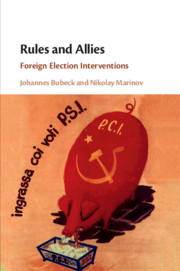Book contents
- Frontmatter
- Contents
- List of Figures
- List of Tables
- Acknowledgements
- 1 Introduction
- 2 Anarchy and Polyarchy
- 3 The Who and the How of Elections: A Theory with Interested Outsiders
- 4 Actors, Policies, Strategies: Original Data on Electoral Interventions
- 5 How Election Interventions Work: A Look at the Evidence
- 6 Captain America
- 7 When Money Runs Low and Regime Overthrow
- 8 Buying Allies
- 9 Conclusion
- Appendix
- References
- Subject Index
- Author Index
3 - The Who and the How of Elections: A Theory with Interested Outsiders
Published online by Cambridge University Press: 15 July 2019
- Frontmatter
- Contents
- List of Figures
- List of Tables
- Acknowledgements
- 1 Introduction
- 2 Anarchy and Polyarchy
- 3 The Who and the How of Elections: A Theory with Interested Outsiders
- 4 Actors, Policies, Strategies: Original Data on Electoral Interventions
- 5 How Election Interventions Work: A Look at the Evidence
- 6 Captain America
- 7 When Money Runs Low and Regime Overthrow
- 8 Buying Allies
- 9 Conclusion
- Appendix
- References
- Subject Index
- Author Index
Summary
In this chapter, we introduce the bare-bones model of electoral interventions in elections. The theoretical argument we develop produces a rich variety of comparative statics. We amend many aspects of the conventional wisdom. A state which acts as a liberal hegemon in a foreign election does not always promote more democratic elections. Two liberal outsiders in conflict are better for democratic elections. Conflicts between liberal and illiberal powers do produce some of the worst outcomes as far as clean elections go.
Keywords
- Type
- Chapter
- Information
- Rules and AlliesForeign Election Interventions, pp. 43 - 68Publisher: Cambridge University PressPrint publication year: 2019

